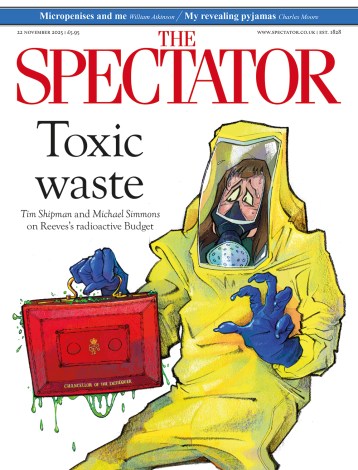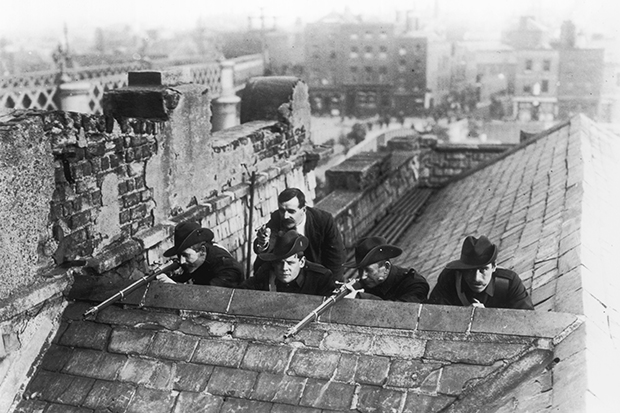This is the first exhibition I’ve been to where the Prime Minister joined the hacks at the press view. A week after the Irish general election, the Taoiseach, Enda Kenny, came to the biggest show in Ireland devoted to the centenary of the Easter Rising. Kenny’s presence at the press launch just goes to show how the Irish rebellion against British rule at Easter 1916 is still the defining story of modern Ireland.
In fact, the Easter Rising was a pretty good failure, although I didn’t suggest that to the Prime Minister at the press view. The rebellion lasted only six days before it was put down by the British army. Other attacks on British barracks in Meath, Galway and Wexford didn’t get very far either. Planned attacks in Cork, Tyrone and Donegal never happened. And Irish independence didn’t come until 1922, after the War of Independence.
But, still, the Easter Rising is treated with a holy reverence — partly because it happened in Easter Week in a devout country; more because of the brutal treatment of the rebels. Sixteen of them were executed — and they quickly became political martyrs, tinged with a semi-religious aura.
That reverence for the Rising and its leaders is what makes this comprehensive show so gripping. What had been a fairly small-scale rebellion was immediately treated as the definitive spiritual battle on an island soaked for centuries with the blood of thousands, from dozens of battles. As a result, the 300 objects in this show were also immediately treated with the reverence shown to religious relics. And what an exceptional, captivating collection of relics they are.
Some of them have the inevitable macabre fascination of things associated with fighting and death. One oddly heart-stopping object is a cricket bat from Elvery’s shop window on Sackville Street, which was caught up in the shooting and looting that began on the afternoon of Easter Monday. Hit by the crossfire, the bat still has a bullet lodged in it.
After the Rising, the most everyday things took on a holy green hue, among them the blocks of metal print used for the ‘Proclamation of the Irish Republic’. Even the printers’ huge battered table, on which they laid out the print, is on show. Nearby is the holiest of holies — the green flag, with ‘Irish Republic’ in gold Celtic letters, which flew from the flagpole of the General Post Office on O’Connell Street (then Sackville Street), the headquarters of the Rising’s leaders. Captured by soldiers of the Royal Irish Regiment, the flag was given to George V, before it was donated to the Irish government in 1966 on the Rising’s 50th anniversary.
The poignant story of the 200,000 Irishmen who fought in the first world war for a nation their countrymen were rebelling against is movingly and objectively told. One extraordinary surviving artefact is a handwritten poster erected by Germans opposite the trenches of the Royal Munster Fusiliers on the Western Front during the uprising. ‘Irishmen!’ the German poster reads in stilted English, ‘Heavy uproar in Ireland, English guns are firing at your wifes [sic] and children!’
That poster was lent to the exhibition by the Queen — a sign of how much Anglo-Irish relations have improved in recent years. The Queen’s trip to Ireland in 2011 was the first visit of a British monarch there in a century.
And it wasn’t so long ago that the Irish contribution to Allied efforts in the first world war was kept extremely quiet. The history of the Irishmen at the Western Front during the Easter Rising is recorded without judgment; most stirringly through the cigarette case of Harry Mitchelson, a 20-year-old cinema projectionist in Phibsborough, Dublin, who joined the West Yorkshire Regiment in September 1915. The inscription on the case reads, ‘With best wishes. From the Proprietor and Staff of the Bohemian Picture Theatre, Dublin. Sept 11th 1915.’ Fifteen months after reaching the Front, Mitchelson was dead.
Naturally, the exhibition is extremely green overall, as you’d expect of a show devoted to the national event of a country in its national museum. But there is no tub-thumping, or any unpleasant jingoism. It covers the British soldiers at the Easter Rising, too, not least the Georgius Rex, the British Home Guard, known by Dubliners as the ‘Gorgeous Wrecks’, thanks to their advanced age. There was outrage in Dublin when one Gorgeous Wreck, Francis Browning, 47, was shot, unarmed, on returning from a training day. From then on, the rebels ordered that only armed soldiers should be targeted.
The aftermath of the Rising is just as comprehensively treated, not least through the nun’s outfit worn by one rebel, Liam Mellows, as he fled Ireland for America. The most revered of all the carefully preserved relics are items used by the rebels imprisoned after the failed rebellion. Among them is the tablecloth that covered the table on which Mass was celebrated by prisoners in Dublin’s Richmond Barracks. Even the prison biscuits given to jailed rebels have survived — the ultimate sign that anything associated with the Rising, however disposable, immediately assumed hallowed status.
The setting of the exhibition played its part in the Easter Rising, too. The National Museum of Ireland is housed in the Collins Barracks — named after Michael Collins, the Irish revolutionary leader who fought at the Easter Rising and was later killed in the Irish Civil War. In fact, the vast, spare, classical barracks were originally built in 1702 for the British army. This was where Wolfe Tone, hero of the Irish Rebellion of 1798, was imprisoned and court-martialled. And it was a crucial British army barracks during the Easter Rising.
Everywhere you walk through Dublin’s Georgian streets, you are reminded of the city’s British past. Still, a century after the Easter Rising, the rebellion has now passed from living memory into history. It’s striking that, even though the Prime Minister came to the show, the first questions the press asked were about last month’s general election, not the Rising itself. The Rising remains Ireland’s most important historical event; it is no longer its number-one modern political issue.
At Dublin airport, I even saw a poster for an Easter Rising bus trip, ‘The 1916 Tour — Beyond Barricades: a dramatic, theatrical tour… with performances by award-winning theatre company Anu Productions.’ You couldn’t have made a tourist attraction out of the Easter Rising until very recently.
Still, only this month, dissident republicans stuck a bomb under a prison officer’s car in east Belfast. The Police Service of Northern Ireland said it was worried about republicans stepping up their attacks to mark the Rising’s centenary. The shock waves of 1916 haven’t settled quite yet.






Comments